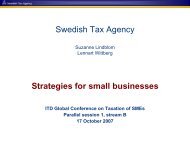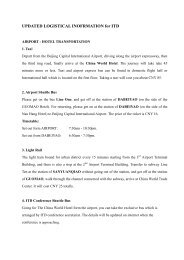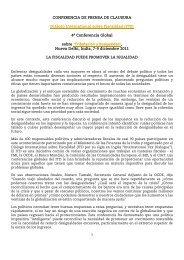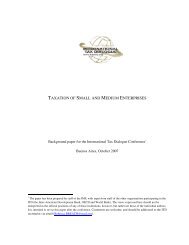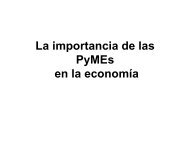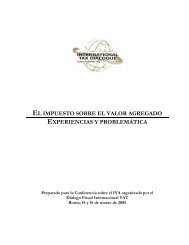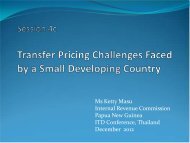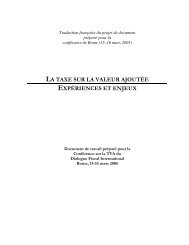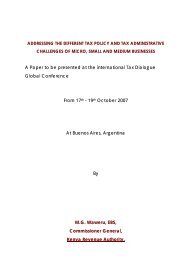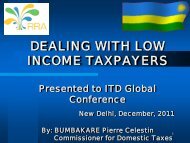Arcotia Hatsidimitris - International Tax Dialogue
Arcotia Hatsidimitris - International Tax Dialogue
Arcotia Hatsidimitris - International Tax Dialogue
Create successful ePaper yourself
Turn your PDF publications into a flip-book with our unique Google optimized e-Paper software.
22 – 2. SELECTING THE RIGHT CASES<br />
Box 1. The transfer pricing risk assessment process in Denmark<br />
• The risk assessment process in Denmark has a three-step approach.<br />
• The first step involves a comprehensive identification of risk areas. The second step is a computer<br />
based process bringing together tax information and details from publicly available data bases. The<br />
third step involves a review of tax returns and accounts to look for indications of transfer pricing risk.<br />
Step 1: Overall risk areas<br />
• In the first step trends and topical issues in transfer pricing are reviewed with a view to identifying<br />
specific risk areas, e.g. ‘loss-making companies’ or transfers of intellectual property’. Looking at the<br />
detail of the approach:<br />
<br />
<br />
Transfer pricing leaders are asked to think about the full range of risk areas.<br />
A group of transfer pricing specialists are brought together to evaluate and prioritise the<br />
identified risks by reference to four factors:<br />
• How much tax is at risk because of each specific risk?<br />
• What is the danger that the risk will spread within the MNE and to other MNEs?<br />
• Are the relevant tax rules known to tax payers and easy to follow?<br />
• How can the risk best be managed?<br />
<br />
Step 2: IT based<br />
A prioritised list of risks is drawn up and forms the basis of a work program for the year. Most<br />
casework will be carried out on a project basis focusing on a specific risk area. For a number of<br />
years the key risk areas have been similar, with the main ones being loss-making companies<br />
and transfer of intellectual property.<br />
• The second step of the risk assessment process involves an IT process where taxpayer data held by<br />
the tax administration is combined with publicly available data (e.g. Amadeus) to narrow down the<br />
population of companies to be subjected to further consideration.<br />
• For example, equity funds are known to be a high risk area. A comprehensive search of the Internet<br />
identifies a list of all companies bought or sold by equity funds in the past 10 years. The list has<br />
been developed by a university and is publicly available. Financial data for all of the companies on<br />
the list are found in Amadeus and criteria are then applied to narrow down to a manageable size the<br />
population of companies that might be suitable for audit.<br />
• Using multiple indicators of risk can be helpful in identifying cases for audit in that the actual number<br />
of risks can of itself be a way of prioritising cases. With equity funds such multiple indicators could<br />
be large changes in interest payments, size of interest payments, dividends payments or country of<br />
ultimate owner. Other examples include legal form and structure, branches, activity description,<br />
nature and size of income, loss deduction, dividends or tax exemptions.<br />
At the end of Step 2 there are lists of companies marked either ‘potentially suitable for audit’ or ‘not<br />
suitable for audit’. All the ones marked ‘potentially suitable for audit’ will move on to Step 3.<br />
Step 3: Manual intervention<br />
• The third step is an examination of the tax returns and financial data of the companies to see if they<br />
should be subject to a transfer pricing audit. The step will lead to a list of companies suitable for<br />
audit – prioritised in case resources limit the number of audits that can be opened.<br />
DEALING EFFECTIVELY WITH THE CHALLENGES OF TRANSFER PRICING © OECD 2012



